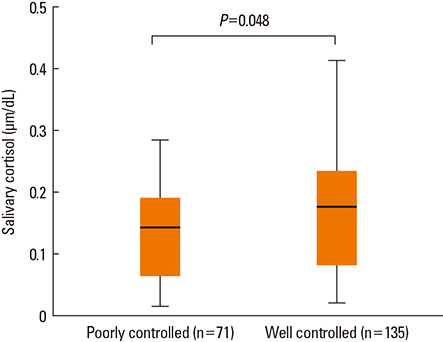Allergy Asthma Immunol Res.
2014 Sep;6(5):463-466. 10.4168/aair.2014.6.5.463.
The Impact of Asthma Control on Salivary Cortisol Level in Adult Asthmatics
- Affiliations
-
- 1Department of Allergy and Clinical Immunology, Ajou University School of Medicine, Suwon, Korea. hspark@ajou.ac.kr
- 2Division of Pulmonary, Allergy, and Critical Care Medicine, Department of Medicine, Hallym University Sacred Heart Hospital, Hallym University College of Medicine, Anyang, Korea.
- 3Department of Internal Medicine, Dong-A University School of Medicine, Busan, Korea.
- 4Department of Internal Medicine, Kosin University College of Medicine, Busan, Korea.
- KMID: 2181084
- DOI: http://doi.org/10.4168/aair.2014.6.5.463
Abstract
- Asthma is a chronic disease causing psychological stress which leads to the activation of hypothalamus-pituitary-adrenal axis. The purpose of this study is to compare morning salivary cortisol levels in persistent asthma patients according to their disease severities and control status. Total 206 adult asthma patients were recruited from four university hospitals. Spirometry, questionnaire of Asthma Quality of Life (AQOL) and Asthma Control Test (ACT) were completed, and saliva samples were collected prospectively to measure morning cortisol level. The mean patient age was 56.5+/-15.3 years with mean asthma duration of 9.1+/-11.1 years. Sixty five patents (31.6%) were classified as mild persistent asthma, and 141 patients (68.4%) were classified as moderate persistent asthma according to the Expert Panel Report 3. The mean predicted FEV1 was 88.8%+/-18.4%, and the methacholine PC20 was 9.6+/-8.5 mg/mL in all study population. The mean ACT score for all patients was 19.9+/-3.6, and there were 71 (34.5%) patients in poorly controlled and 135 (65.5%) in well controlled asthma. The poorly controlled asthma patients were characterized by significantly lower FEV1 (84.6%+/-17.6% vs 91.1%+/-18.5%, P=0.018), lower AQOL scores (46.0+/-13.9 vs 73.8+/-26.3, P<0.001), and lower salivary cortisol levels (0.14+/-0.08 vs 0.18+/-0.11 microg/dL, P=0.04) compared to well controlled asthma. The ACT score was significantly related to salivary cortisol levels (P=0.034) after adjusting for age. There was no significant difference in salivary cortisol levels (0.17+/-0.12 vs 0.16+/-0.08, P=0.725) when analyzed according to the dose of used corticosteroid and lung function. Asthma control status affects morning salivary cortisol level. Measuring the morning salivary cortisol level might be a simple and new way to assess asthma control status.
Keyword
MeSH Terms
Figure
Reference
-
1. Oraka E, King ME, Callahan DB. Asthma and serious psychological distress: prevalence and risk factors among US adults, 2001-2007. Chest. 2010; 137:609–616.2. Forsythe P, Ebeling C, Gordon JR, Befus AD, Vliagoftis H. Opposing effects of short- and long-term stress on airway inflammation. Am J Respir Crit Care Med. 2004; 169:220–226.3. Ahn RS, Lee YJ, Choi JY, Kwon HB, Chun SI. Salivary cortisol and DHEA levels in the Korean population: age-related differences, diurnal rhythm, and correlations with serum levels. Yonsei Med J. 2007; 48:379–388.4. Bakkeheim E, Mowinckel P, Carlsen KH, Burney P, Lødrup Carlsen KC. Reduced basal salivary cortisol in children with asthma and allergic rhinitis. Acta Paediatr. 2010; 99:1705–1711.5. Lee EH, Kim SH, Choi JH, Jee YK, Nahm DH, Park HS. Development and evaluation of an Asthma-Specific Quality of Life (A-QOL) questionnaire. J Asthma. 2009; 46:716–721.6. Hwang EK, Jin HJ, Nam YH, Shin YS, Ye YM, Nahm DH, Park HS. The predictors of poorly controlled asthma in elderly. Allergy Asthma Immunol Res. 2012; 4:270–276.7. Thomas M, Kay S, Pike J, Williams A, Rosenzweig JR, Hillyer EV, Price D. The Asthma Control Test (ACT) as a predictor of GINA guideline-defined asthma control: analysis of a multinational cross-sectional survey. Prim Care Respir J. 2009; 18:41–49.8. Busse WW, Lemanske RF Jr. Expert panel report 3: moving forward to improve asthma care. J Allergy Clin Immunol. 2007; 120:1012–1014.9. Gröschl M, Rauh M, Dörr HG. Circadian rhythm of salivary cortisol, 17alpha-hydroxyprogesterone, and progesterone in healthy children. Clin Chem. 2003; 49:1688–1691.10. Chung MC, Rudd H, Wall N. Posttraumatic stress disorder following asthma attack (post-asthma attack PTSD) and psychiatric co-morbidity: the impact of alexithymia and coping. Psychiatry Res. 2012; 197:246–252.11. Petrelluzzi KF, Garcia MC, Petta CA, Grassi-Kassisse DM, Spadari-Bratfisch RC. Salivary cortisol concentrations, stress and quality of life in women with endometriosis and chronic pelvic pain. Stress. 2008; 11:390–397.
- Full Text Links
- Actions
-
Cited
- CITED
-
- Close
- Share
- Similar articles
-
- Comparative Analysis of Salivary Cortisol in Young Adult Patients with Temporomandibular Disorders
- Exploring Subjective Stress, Sleep and Diurnal Variation of Salivary Cortisol in Korean Female Adults
- The Changes of Salivary Cortisol and Electrolytes during Nursing Practice of Nursing Students
- An Exploratory Study on Occupational Stress and Anxiety Through Salivary Cortisol and Self-Report Scale in Korean Nurses on Shift and Regular Work
- Asthma in the elderly



